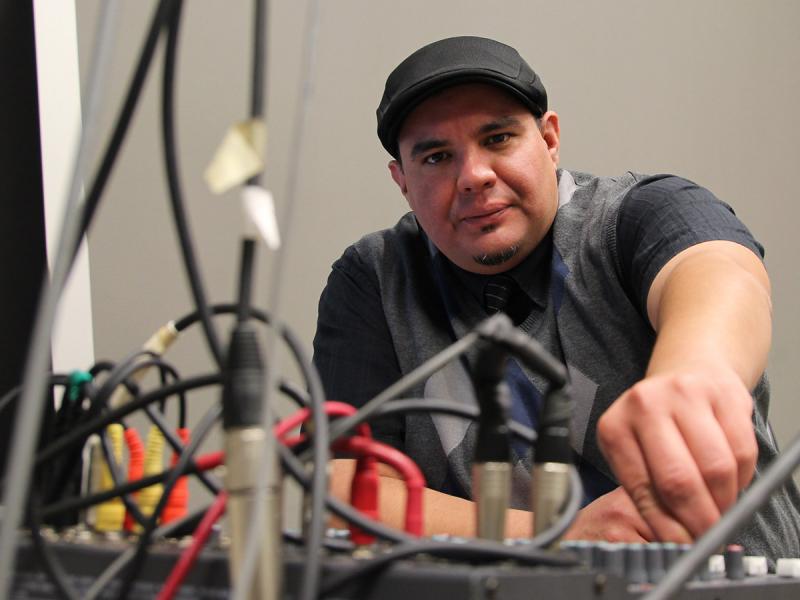Jackson 2Bears moves from alumni to Audain
- John Threlfall

When it comes to the Department of Visual Arts, Jackson 2Bears is not the typical Audain Professor of Contemporary Arts of the Pacific Northwest. Although he has yet to achieve the international reputation of previous Audain professors Rebecca Belmore, Michael Nicol Yahgulanaas and Nicholas Galanin, he is the first UVic alumnus to be appointed to the position.
A Kanien’kehaka (Mohawk) artist, 2Bears works with new media, interactive installations and multimedia performances to reflect on issues of racism, colonialism, discrimination, Indigenous subjectivity and Native stereotypes. A frequent face around campus, he has previously taught for both Visual Arts and the Pacific Centre for Technology and Culture. “I’ve been at UVic a long time, both as a Masters and a PhD student, so part of my role is to bring some of those other areas and people together with Fine Arts,” he says. “My personal project is to start plugging the Audain position a bit more into the rest of the university.”
2Bears describes his current practice as focusing on “the aesthetics of Indigenous identity in contemporary times. I envision my practice as a form of cultural critique in which I explore alternative ways to engage with the question of Native spirituality in our modern, technological society.” Yet he sees no clash between traditional First Nations art and the more contemporary practice the Audain position was created to highlight. “It’s a strange misconception of the traditionalists that Indigenous culture happened a long time ago—that we’re always having to go back to the past,” he says, paraphrasing noted American Indian author Vine Desloria Jr. “But a crucial part of our tradition is change, transformation, evolution.”
2Bears also embraces change in his teaching. “One thing I learned from Taiaiake Alfred in the Indigenous Governance program was about encouraging non-Indigenous students to approach things from their own perspectives,” he says. “We all participate in this landscape called Canada, so it’s not about imagining themselves as an Indigenous person, but approaching things from their own cultural backgrounds.”
When asked what he’ll bring to his Audain seminars—created in 2009 as part of a $2-million gift from celebrated BC art philanthropist Michael Audain and the Audain Foundation—2Bears doesn’t hesitate. “The course is meant to be quite organic and geared toward whoever is teaching it and their specialty,” he says. “For me, that means an interest in contemporary First Nations art and an interest in larger social and political issues.”
It will also mean exposing his students to his own performance art. Primarily inspired by electronic music and DJ/VJ culture, 2Bears uses remix as a tool for cultural critique. “A lot of what I’ve been doing over the past few years is live cinema—scratch video, I call it,” he explains. “Picture a DJ with turntables, but instead of just scratching music you can play video: spinning the turntables backwards and forward, using the mixer not just for volume but also for brightness and cross-fading. What I want to do as an artist-in-residence is build some sort of video synthesizer, where I take an analogue keyboard and make it not only produce sound but video as well. I’m also working on some pow-wow drums that will project video images when you play them.”
Beyond instilling a greater appreciation for contemporary Indigenous art, 2Bears sees the artist-in-residence aspect as a key aspect of the Audain position. “It’s good for the students to see their professors struggling with the same decision-making processes, how to actually produce art. It’s too easy for students to see professors as really successful artists where they work hidden away in their studios—but it’s really fantastic to be involved in a more community-like aspect. It changes that whole professor-student relationship.”

